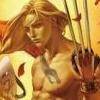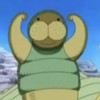Legaia 2: Duel Saga (PlayStation 2) review"Legaia 2: Duel Saga seems to be a throwback to old-school JRPGs, which might satisfy the hardcore RPG gamer looking for some nostalgia. But while striving for the old-school vibe it throws away the many things that made the original Legend of Legaia so innovative and endearing. It is hard for me to recommend this game to fans of the original that may have higher expectations. But then again, it is hard to recommend this game to RPG newcomers as well." |
While going through the first few hours of Legaia 2: Duel Saga I was having the time of my life. The recycled music and modified Tactical Arts System from Legend of Legaia aroused a swarm of nostalgic feelings. But as the hours passed my mood started to darken, and eventually it turned from excitement to annoyance. Indeed, by the time I completed the game I was left with an empty feeling. Legaia 2: Duel Saga is the quintessential example of a sequel that rids itself of all the charm carried by its predecessor while adding features that do not make up for its shortcomings.
As the game starts, we a black-haired teenager named Lang with a mysterious mark on his chest being woken up by his overbearing foster sister as she starts pounding a bucket with a wooden spoon. After being informed that he is late for training, Lang wanders outside to see the Vigilance Corps in the middle of practice. Lang is a new member of the Vigilance Corps, and his job is to patrol the nearby woods and eliminate monsters that may potentially wander into the village.
What starts off as a routine monster killing ends up a quest for the fate of the village as a mysterious man with a tattoo just like Lang nearly kills him with demonic powers in the woods and takes off with the village’s Aqualith, a mysterious crystal that pours an infinite supply of water into its lake. Lang journeys after the man and finds himself captured by other beings with tattoos and demonic powers and sent to a castle dungeon, where he joins with another like him and escapes to find an old hermit on a mountain. We soon learn that it is not just Lang’s village at stake, but rather the entire world, and so Lang continues to search for the mysterious man that attacked him, all the while learning more about what the strange mark on his chest means and recruiting party members along the way.
Duel Saga’s decision to go the Final Fantasy route and tell a story with no similarity to the prequel ends up being a big mistake. While Legend of Legaia had a relatively straightforward story, it had enough charm, twists, and similarities to religious mythology that made it quite engaging. Duel Saga, however, takes every single RPG cliché and wraps it into one big mess.
Mysterious villain who wants to destroy humanity out of revenge? Check.
Race of people persecuted by humans? Check.
Magical crystals that have awesome powers? Check.
A main character that doesn’t know who he really is? Check.
Old alcoholic martial arts master who had a falling out with a prior student? Check.
A final showdown at the center of the earth after going down a large crater? Check.
These are just some of the overbearing JRPG cliches present.
The villains have uninteresting motives, save for a few, and by the time you learn of them it is too late to matter. The main characters are essentially the exact same people at the end of the story as they are at the beginning and have no development to speak of. Some characters even join the party with no reason at all. As an example, there is a giant who joins the party after his village chief basically says to your characters “Here’s the strongest guy we have, he’ll help you out.” It is all very straightforward and unimaginative, and I felt like I had seen this story a hundred times before.
The character designs are all pretty neat, however. The main three out of the five party members are a bit too close to the character designs of the trio from Legend of Legaia, but they’re all pretty cool looking as a unit. Though graphics are pretty detailed for the character models, in battles especially, the backdrops are very plain and filled with such little detail that it’s possible the same graphics could have been rendered on the PSX. What makes matters worse is the fact that the story takes you through some of the same dungeons over three times each in order to pad on extra hours of playtime, meaning you will see the same drab, blocky gray stones or plain green grass in the background multiple times throughout the entire game. While there are in-game cutscenes, they are made using the battle engine and there are no FMVs in sight. Put simply, the game's graphics do not really hold up, especially considering that Duel Saga released around the same time as games like Final Fantasy X. Luckily the enemy designs are rather creative and the battle effects look cool, but it is not enough to consider the game up to standard in the visuals department.
One will quickly notice that the Tactical Arts System (TAS) returns from the prequel, in which instead of selecting a standard ‘Attack’ button, directional buttons are used to input combos. With particular combinations, special moves called Arts are unlocked. The system has been tweaked however, in the sense that normal Arts gain attack power while Super Arts and the like expend attack power. This means no charging for AP every other turn like in the original battle system. New types of Arts have also been added that let you combine character attacks into one, or attack at the same time as your Origin as well.
What could have been a great modification is set back, as during every single Art there is a long pause and zoom in on the character. In larger combos this can happen five or six times. Imagine seeing that zoom-in Matrix effect 30+ times in a single battle. Coupled with the fact that the encounter rate is so high, what is originally fun becomes boring quickly. The magic system has also been dumbed down, as instead of capturing magic a la Pokémon like in the original, your party’s Origin spells are maxed at around 4 each character and new spells can only be learned by leveling them up. Hardly exciting.
One of the unfortunate things that developers tend to do when responding to fan backlash at certain elements of their games is changing the particular aspect to the extreme, and the developers of Duel Saga did exactly this.
World map movement was a bit too slow in the original, so what do they do? They take out the interactive world map entirely and replace it with a point and click scheme that warps you to the unlocked town instantly, consequently making the world feel much smaller. Bosses in the original tended to frustrate people with their difficulty, while random enemies were relatively easy in comparison. So what do the developers do? They make random encounters insanely brutal to the point where you can be ambushed and killed before getting a turn while making story bosses killable in three or four rounds and lacking any real strategy. Some people didn’t like not being able to understand the Japanese battle cries in the original, so what’s the remedy? Eidos replaces the Japanese voice acting with unbearably hammy and cringe-worthy English voice acting from a mostly uncredited Canadian cast. Mazes in the original too straightforward? Find yourself fighting random battles for hours because you cannot find out how to get through one of Duel Saga's brutal dungeon mazes.
For some reason, features that were lauded by players of the original game were scrapped as well. Legend of Legaia allowed you to see graphics for equippable armor, something that very few RPGs did at the time. Duel Saga takes this feature out, and now only weapon changes are shown in battle graphics. The convenient Door of Light item that let you instantly warp out of dungeons has been removed and now escaping dungeons requires traveling through the same area once again. Characters now jump back into place after attacking, which discards some of the realism from the battle system in the previous game, and nice touches like seeing characters run into the distance until disappearing when escaping have been discarded – now when characters choose to run away you see them jogging in place.
There are some nice things Duel Saga offers, however. The music in the game is quite good, containing some remixed tracks of songs from the first game by Michiru Oshima, as well as original pieces by composers Yasunori Mitsuda and Hitoshi Sakimoto. Additionally, the mini-games such as rice planting and the casino, sidequests like the Hunter's Guild, fighting tournaments, cooking, camping, crafting and item synthesis, and hidden scenes with hilarious character interactions are numerous. I found these much more fun than the main game. But then again, when mini-games are more time consuming and enjoyable than the main quest, there is certainly a problem.
Legaia 2: Duel Saga seems to be a throwback to old-school JRPGs, which might satisfy the hardcore RPG gamer looking for some nostalgia. But while striving for the old-school vibe it throws away the many things that made the original Legend of Legaia so innovative and endearing. It is hard for me to recommend this game to fans of the original that may have higher expectations. But then again, it is hard to recommend this game to RPG newcomers as well.
 |  |  |  |  |
Featured community review by Sise-Neg (April 07, 2012)
A bio for this contributor is currently unavailable, but check back soon to see if that changes. If you are the author of this review, you can update your bio from the Settings page. |
|
More Reviews by Sise-Neg [+]
|
|
If you enjoyed this Legaia 2: Duel Saga review, you're encouraged to discuss it with the author and with other members of the site's community. If you don't already have an HonestGamers account, you can sign up for one in a snap. Thank you for reading!
User Help | Contact | Ethics | Sponsor Guide | Links









